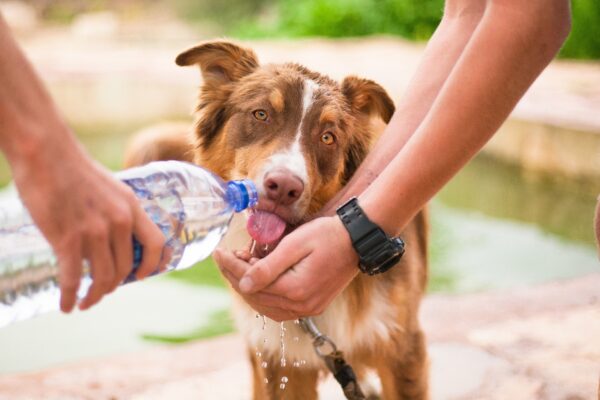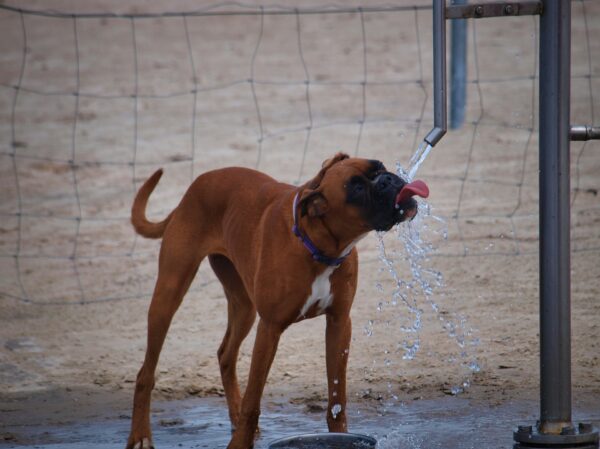People often look forward to the warm weather of summer, but dogs are not always excited about it. That’s because heat stroke in dogs is more common for them than it is for humans. Even with all the warnings about hot temperatures, many dog parents still don’t take extra precautions. Going for a long walk or playing in the yard could cause health problems for your dog if the sun is blazing down on them. So, it’s important to be careful during hot weather to ensure that your dog doesn’t suffer from heat stroke.
What is Heat Stroke in Dogs?
Heat stroke, heat exhaustion, and hyperthermia all occur when your dog gets too hot. Their body temperature will rise above a healthy condition, causing them to no longer be able to regulate their body heat. Mild heat exhaustion can be treated at home, but severe heat stroke could require immediate vet care. With heat stroke, your dog could lose consciousness, get a high fever, or even have organ failure.

103 degrees Fahrenheit is considered a high body temperature for a dog. If your dog has no previous illness symptoms, a temperature of 106 degrees likely means that they received too much heat exposure and should be cared for right away. Temperatures of 107 degrees or higher are critical. Your dog could be at risk of organ failure or death, so it’s important to seek help right away.
Dogs can’t regulate their body temperature as easily as humans can. They pant instead of sweat, which isn’t as effective. Additionally, other factors could make your dog even more prone to heat stroke. Overweight dogs, dogs with thick coats, and dogs with flat faces are all more likely to get heat stroke. Yet, all dogs are still at risk during hot summer days.
What Does Heat Stroke for Dogs Look Like?
If it’s hot outside, make sure you pay close attention to your dog’s behaviors. Your dog should be cooled down right away if they show signs of heat exhaustion or heat stroke.
Here are some common signs of heat stroke in dogs:
- Excessive panting
- Bright red tongue
- Red, gray, blue, or purple gums
- Rapid heart rate
- Dehydration
- Excessive drooling
- Sticky saliva
- Fever
- Vomiting
- Diarrhea
- Dizziness
- Seizures
- Collapsing

If your dog displays one or more of these symptoms, bring them into the shade or air conditioning if possible. Placing a cool, damp towel on their head or stomach is a great way to help them cool off. Then, have the vet check them out right away.
Which Breeds are Most Likely to Get Heat Stroke?
All dogs can get heat stroke, but it’s much more common for certain breeds. The biggest concern is for brachycephalic dogs, which refers to dogs with flat faces. Breathing problems are the most significant health concerns for these breeds. Thus, it’s easier for them to get heat stroke and harder for them to cool down.
Dogs with thick coats or long hair are also at risk. Some dog breeds have coats built to keep them warm in the winter. Additionally, some dog parents prefer to grow their dog’s hair longer for appearance. Both of these can cause dogs to be hotter in the summer months. Some breeds have double coats to protect them from both warm and cold weather, but they can still suffer from heat stroke.

The following dog breeds are the most at risk of heat stroke:
- Bulldog
- Pug
- Boxer
- Cavalier King Charles Spaniel
- French Bulldog
- Akita
- Boston Terrier
- Pekingese
- American Bulldog
- Shih Tzu
- Chow Chow
- Bullmastiff
Almost all these breeds have shorter snouts than most dogs. Some also have an extra thick coat, like the Akita and Chow Chow. For these reasons, it’s dangerous to keep these breeds out in the sun for long periods of time. If your dog is overweight, they will get tired sooner too. So, you should be extra cautious about letting your overweight dog play in the heat.
How to Prevent Heat Stroke
There are plenty of ways that you can prevent heat stroke before symptoms occur. Once you notice it heating up outside, it’s time to take extra precautions to keep your pup safe.

#1 – Limit Your Dog’s Time Outside
Exercise is important for your dog, but when it’s hot outside, you should monitor their time in the sun. Spread out walks and outdoor playtime into short segments throughout the day. That way, your dog won’t be outside long enough for them to suffer from heat stroke. If possible, make sure your dog stays in the shade during outdoor activities.
#2 – Make Sure Your Dog Has Enough Water
Always have water accessible for your dog, especially outside. Dogs often drink more during the summer, so check their water bowl to make sure it stays full.
#3 – Never Leave Your Dog in a Parked Car
Most dog parents know the dangers of leaving a dog in a parked car by now. Even if it’s only for a few minutes with the windows cracked, the car can heat up and turn into an oven. A parked car can reach 100 degrees after only 10 minutes, even if it’s only 70 degrees outside. It’s important to remember that dogs are more sensitive to heat than humans are. So, cars feel even hotter for them than they do for us.
#4 – Walk Your Dog When the Sun Isn’t Out
Avoid walking your dog in the sun during the hottest months of the year. Take them for walks early in the morning or after the sun goes down at night. If you have to walk during the sunlight, make sure the walks are shorter than usual. Additionally, make sure water is always accessible for your dog. Bring a portable bowl and water bottle if you’re not near your home.

#5 – Keep Your House Cool
Some families turn off the air conditioning now and then to save money, but your home can heat up like a hot car. You don’t have to blast the A/C, but at least keep it on during hot days. It also couldn’t hurt to turn on some fans in the room that your dog usually hangs out in to keep them as cool as possible.
Treatments for Heat Stroke
It’s still possible for heat stroke to occur even if you work hard to prevent it. As soon as you notice the symptoms in your dog, you need to take care of them and rush them to the vet as soon as possible.
Caring for Your Dog at Home
Get your dog out of the heat as soon as they show signs of heat stroke. Your best option is to get them into an air-conditioned space. If you’re not near any shelter, you might have to settle for a shaded area. Put cool water on your dog to help them cool off. Avoid using ice-cold water because cooling them down too fast could cause potential risks. First, put damp towels on their head and stomach. Then, put some on their ears and paws to reduce their risk of fever.
Use a fan to dry off your dog once they start to cool down. Make sure they have cool water accessible to them at all times. It’s important to remember that this water shouldn’t be ice-cold either. Even if your dog seems to be feeling better after a while, you should still contact your vet. If your dog becomes unconscious or if their heat stroke symptoms worsen, they need immediate vet care.

How the Vet Can Help
The sooner you contact your veterinarian, the safer your dog will be. Vets still need to check recovering dogs for related health concerns, such as dehydration, shock, and kidney failure. Even if your dog seems to be “feeling fine”, underlying symptoms of heat stroke may be present. If your dog is still suffering from heat stroke, the vet will continue to cool them down, using more cool water and even oxygen therapy in extreme cases.
After your vet checks your dog’s health, they’ll be able to tell you what the next steps for their care are. Treatment for heat stroke-related problems could range anywhere from $10 all the way to $10,000. That’s why it’s so crucial to have a vet look at your dog before symptoms worsen.
You need to keep an eye out for heat stroke symptoms every time the weather warms up. Never leave your dog outside in the heat for too long and always make sure they have water available. Summer can be a dangerous time of year for dogs, but with enough care and caution, they can survive the intense heat.
H/T: vcahospitals.com
 Toledo, United States.
Toledo, United States.